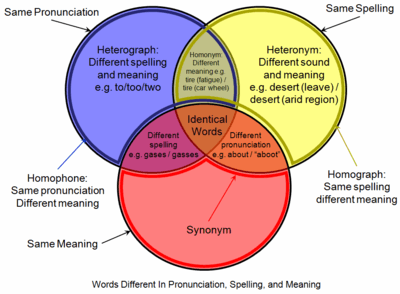Homophone
A homophone is a word that is pronounced the same (to varying extent) as another word but differs in meaning. A homophone may also differ in spelling. The two words may be spelled the same, as in rose (flower) and rose (past tense of rise), or differently, as in rain, reign, and rein. The term "homophone" may also apply to units longer or shorter than words, such as phrases, letters, or groups of letters which are pronounced the same as another phrase, letter, or group of letters. Any unit with this property is said to be "homophonous".

Homophones that are spelled the same are also both homographs and homonyms.[1]
Homophones that are spelled differently are also called heterographs.
Etymology
"Homophone" derives from the Greek homo- (ὁμο‑), "same", and phōnḗ (φωνή), "voice, utterance".
In wordplay and games

Homophones are often used to create puns and to deceive the reader (as in crossword puzzles) or to suggest multiple meanings. The last usage is common in poetry and creative literature. An example of this is seen in Dylan Thomas's radio play Under Milk Wood: "The shops in mourning" where mourning can be heard as mourning or morning. Another vivid example is Thomas Hood's use of "birth" and "berth" and "told" and "toll'd" (tolled) in his poem "Faithless Sally Brown":
- His death, which happen'd in his berth,
- At forty-odd befell:
- They went and told the sexton, and
- The sexton toll'd the bell.
In some accents, various sounds have merged in that they are no longer distinctive, and thus words that differ only by those sounds in an accent that maintains the distinction (a minimal pair) are homophonous in the accent with the merger. Some examples from English are:
- pin and pen in many southern American accents.
- merry, marry, and Mary in most American accents.
- The pairs do, due and forward, foreword are homophonous in most American accents but not in most English accents.
- The pairs talk, torque, and court, caught are distinguished in rhotic accents such as Scottish English and most dialects of American English, but are homophones in many non-rhotic accents such as British Received Pronunciation.
Wordplay is particularly common in English because the multiplicity of linguistic influences offers considerable complication in spelling and meaning and pronunciation compared with other languages.
Malapropisms, which often create a similar comic effect, are usually near-homophones. See also Eggcorn.
Oronyms
Homophones of multiple words or phrases (as sometimes seen in word games) are also known as "oronyms". This term was coined by Gyles Brandreth and first published in his book The Joy of Lex (1980), and it was used in the BBC programme Never Mind the Full Stops, which also featured Brandreth as a guest.
Examples of "oronyms" (which may only be true homophones in certain dialects of English) include:
- "ice cream" vs. "I scream" (as in the popular song "I scream. You scream. We all scream for ice cream.")
- "euthanasia" vs. "Youth in Asia"
- "depend" vs. "deep end"
- "Gemini" vs. "Jim and I" vs. "Jem in eye"
- "the sky" vs. "this guy" (most notably as a mondegreen in Purple Haze by Jimi Hendrix)
- "four candles" vs. "fork handles"
- "sand which is there" vs. "sandwiches there"
- "philanderer" vs. "Flanders"
- "example" vs. "egg sample"
- "some others" vs. "some mothers" vs. "smothers"
In his Appalachian comedy routine, American comedian Jeff Foxworthy frequently uses oronyms which play on exaggerated "country" accents. Notable examples include:
- Initiate: "My wife ate two sandwiches, initiate [and then she ate] a bag o' tater chips."
Mayonnaise: "Mayonnaise [Man, there is] a lot of people here tonight."
Innuendo: "Hey dude I saw a bird fly innuendo [in your window]."
Moustache: "I Moustache [must ask] you a question."
Number of homophones
English
There are sites, for example, this archived page, which have lists of homonyms or rather homophones and even 'multinyms' which have as many as seven spellings. There are differences in such lists due to dialect pronunciations and usage of old words. In English, there are approximately 88 triples; 24 quadruples; 2 quintuples; 1 sextet and 1 septet. The septet is:
- raise, rays, rase, raze, rehs, res, réis
Other than the three common words (raise, rays and raze), there are:
- rase – a verb meaning "to erase";
- rehs – the plural of reh, a mixture of sodium salts found as an efflorescence in India;
- res – the plural of re, a name for one step of the musical scale;
- réis – the plural of real, a currency unit of Portugal and Brazil.
If proper names are allowed then a nonet is Ayr (Scottish town), Aire (Yorkshire River), Eyre (legal term and various geographic locations), heir, air, err (some speakers), ere (poetic "before"), e'er (poetic "ever", some speakers), are (unit of area; some speakers).
German
There are many homophones in present-day standard German. As in other languages, however, there exists regional and/or individual variation in certain groups of words or in single words, so that the number of homophones varies accordingly. Regional variation is especially common in words that exhibit the long vowels ä and e. According to the well-known dictionary Duden, these vowels should be distinguished as /ɛ:/ and /e:/, but this is not always the case, so that words like Ähre (ear of corn) and Ehre (honor) may or may not be homophones. Individual variation is shown by a pair like Gäste (guests) – Geste (gesture), the latter of which varies between /ˈɡe:stə/ and /ˈɡɛstə/ and by a pair like Stiel (handle, stalk) – Stil (style), the latter of which varies between /ʃtiːl/ and /stiːl/. Besides websites that offer extensive lists of German homophones [2], there are others which provide numerous sentences with various types of homophones.[3] In the German language homophones occur in more than 200 cases. Of these, a few are triples like Waagen (weighing scales), Wagen (cart), wagen (to dare) and Waise (orphan) – Weise (way, manner) – weise (wise). The rest are couples like lehren (to teach) – leeren (to empty).
Japanese
There are many homophones in Japanese, due to the use of Sino-Japanese vocabulary, where borrowed words and morphemes from Chinese are widely used in Japanese, but many sound differences, such as the original words' tones, are lost. These are to some extent disambiguated via Japanese pitch accent, or from context, but many of these words are primarily or almost exclusively used in writing, where they are easily distinguished as they are written with different kanji; others are used for puns, which are frequent in Japanese. An extreme example is kikō, which is the pronunciation of at least 22 words (some quite rare or specialized, others common; all these examples are two-character compounds), including: 機構 (organization/mechanism), 紀行 (travelogue), 稀覯 (rare), 騎行 (horseback riding), 貴校 (school (respectful)), 奇功 (outstanding achievement), 貴公 (word for "you" used by men addressing male equals or inferiors), 起稿 (draft), 奇行 (eccentricity), 機巧 (contrivance), 寄港 (stopping at port), 帰校 (returning to school), 気功 (breathing exercise/qigong), 寄稿 (contribute an article/written piece), 機甲 (armor, e.g. of a tank), 帰航 (homeward voyage), 奇効 (remarkable effect), 季候 (season/climate), 気孔 (stoma), 起工 (setting to work), 気候 (climate), 帰港 (returning to port).
Korean
The Korean language contains a combination of words that strictly belong to Korean and words that are loanwords from Chinese. Due to Chinese being pronounced with varying tones and Korean's removal of those tones, and because the modern Korean writing system, Hangeul, has a more finite number of phonemes than, for example, Latin-derived alphabets such as that of English, there are many homonyms with both the same spelling and pronunciation. For example, '화장(化粧)하다': 'to put on makeup' and '화장(火葬)하다': 'to cremate'. Also, '유산(遺産)': 'inheritance' and '유산(流産)': 'miscarriage'. '방구': 'fart', and '방구(防具)': 'guard'. '밤[밤ː]': 'chestnut', and '밤': 'night'. There are heterographs, but far fewer, contrary to the tendency in English. For example, '학문(學問)': 'learning', and '항문(肛門)': 'anus'. Using hanja (한자; 漢字), which are Chinese characters, such words are written differently.
As in other languages, Korean homonyms can be used to make puns. The context in which the word is used indicates which meaning is intended by the speaker or writer.
Use in psychological research
Pseudo-homophones
Pseudo-homophones are pseudowords that are phonetically identical to a word. For example, groan/grone and crane/crain are pseudo-homophone pairs, whereas plane/plain is a homophone pair since both letter strings are recognised words. Both types of pairs are used in lexical decision tasks to investigate word recognition.[4]
Use as ambiguous information
Homophones, specifically heterographs, where one spelling is of a threatening nature and one is not (e.g. slay/sleigh, war/wore) have been used in studies of anxiety as a test of cognitive models that those with high anxiety tend to interpret ambiguous information in a threatening manner.[5]
Bibliography
- Franklyn, Julian (1966). Which Witch? (1st ed.). New York: Dorset Press. ISBN 0-88029-164-8.
See also
- Heterography and homography
- Heteronym (linguistics)
- Dajare, a type of wordplay involving similar-sounding phrases
- Perfect rhyme
- Wiktionary
References
- According to the strict sense of homonyms as words with the same spelling and pronunciation; however, homonyms according to the loose sense common in nontechnical contexts are words with the same spelling or pronunciation, in which case all homophones are also homonyms. Random House Unabridged Dictionary entry for "homonym" at Dictionary.com
- See, e.g.,
- See Fausto Cercignani, Beispielsätze mit deutschen Homophonen (Example sentences with German homophones).
- Martin, R. C. (1982). The pseudohomophone effect: The role of visual similarity in nonword decisions. Quarterly Journal of Experimental Psychology, 34A, 395-409.
- Mogg K, Bradley BP, Miller T, Potts H, Glenwright J, Kentish J (1994). Interpretation of homophones related to threat: Anxiety or response bias effects? Cognitive Therapy and Research, 18(5), 461-77. doi:10.1007/BF02357754
External links
| Look up homophone in Wiktionary, the free dictionary. |
- Homophone.com – a list of American homophones with a searchable database.
- Reed's Homophones – a book of sound-alike words published in 2012
- Homophones.ml – a collection of homophones and their definitions
- Homophone Machine – swaps homophones in any sentence